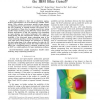Free Online Productivity Tools
i2Speak
i2Symbol
i2OCR
iTex2Img
iWeb2Print
iWeb2Shot
i2Type
iPdf2Split
iPdf2Merge
i2Bopomofo
i2Arabic
i2Style
i2Image
i2PDF
iLatex2Rtf
Sci2ools
114
Voted
ICPP
2009
IEEE
2009
IEEE
End-to-End Study of Parallel Volume Rendering on the IBM Blue Gene/P
—In addition to their role as simulation engines, modern supercomputers can be harnessed for scientific visualization. Their extensive concurrency, parallel storage systems, and high-performance interconnects can mitigate the expanding size and complexity of scientific datasets and prepare for in situ visualization of these data. In ongoing research into testing parallel volume rendering on the IBM Blue Gene/P (BG/P), we measure performance of disk I/O, rendering, and compositing on large datasets, and evaluate bottlenecks with respect to system-specific I/O and communication patterns. To extend the scalability of the direct-send image compositing stage of the volume rendering algorithm, we limit the number of compositing cores when many small messages are exchanged. To improve the data-loading stage of the volume renderer, we study the I/O signatures of the algorithm in detail. The results of this research affirm that a distributed-memory computing architecture such as BG/P is a...
Distributed And Parallel Computing | ICPP 2009 | Parallel Volume | Scientific Visualization | Volume Rendering |
| Added | 23 May 2010 |
| Updated | 23 May 2010 |
| Type | Conference |
| Year | 2009 |
| Where | ICPP |
| Authors | Tom Peterka, Hongfeng Yu, Robert B. Ross, Kwan-Liu Ma, Robert Latham |
Comments (0)

